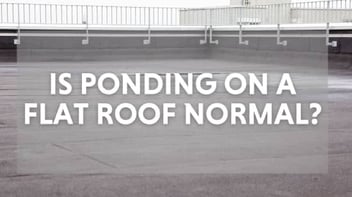- Home »
- Learningcenter »
- How does a flat roof drain
How Does A Flat Roof Drain? - A Guide for Owners and Managers

If you've ever thought about a flat roof, you may have wondered: how do they drain anyway? While flat roofs may seem pretty straightforward, they are actually complex roofing systems. The words "flat roof" are actually deceiving, because all roofs must have a slope, no roof is ever completely flat. In these systems there are specially engineered ways that flat roofs drain - in this article we'll talk about some of the main ones: scuppers, crickets, central roof drains, and gutter systems.
Why Is Draining So Important?
Flat roofs are prone to ponding, and standing water on a roof is never a good thing. Standing water on a flat roof is especially worrisome, as it can cause the membrane to fail. Ponding water also carries dirt and debris, and will leave dark spots, especially on white membranes. This leaves the membrane vulnerable to UV rays, which can break it down and eventually cause it to fail - so drainage systems on flat roofs are extremely important. But how do they work? Lets talk about the main types.
Scuppers
Roof scuppers are rectangular outlets in a parapet wall at the roofs edge that function as a drainage device. Scuppers allow water to drain through an opening in a roofs edge, and are one of the most common and most effective ways that flat roofs drain. Scuppers are used in combination with the design of the roofing system to direct water to the edge and allow it to drain instead of pond on the roof. Scuppers usually channel water into gutters or downspouts, where it can make its way down the side of the building to a storm drain or the concrete below.
Crickets
Another important component in the way flat roofs drain is the use of crickets. A cricket is a triangular structure used to divert water away from certain areas on a roof where it may become trapped, similar to chimney crickets in residential roofing systems. In commercial roofing, crickets are almost always made out of insulation. The insulation is built up under the roof membrane in such a way that it creates a triangular structure, adding a little more slope to the roof to prevent water ponding. Roof crickets are usually placed near walls, around HVAC units and skylights, and around drains. When properly designed, crickets are extremely effective at diverting water where it needs to go to drain off of the roof, and protecting against the issues that come along with standing water.
Central Roof Drains
Central roof drains, also called "inner drains" are often found on commercial roofs. These drains are placed at the center of a roof, and roof crickets, or the natural roof slope are used to direct water to these areas. These drains are a particularly good option for very large roofing systems. They attach to pipes that run down through the building's roof to carry water down and out of the building safely. These drains are also a great option for colder climates, because they are not vulnerable to freezing and cracking during the winter since they are protected by the buildings insulation.
Gutters
Rain gutters are the most common type of drainage system for all roofs. Gutters are favored because they are the simplest and easiest type of drain to install. They keep water from pouring off the roof and pooling and building up around the buildings foundation. While inexpensive, gutters also require the most maintenance, because they need to be regularly cleaned to remain free of debris, they also may become brittle and crack, and are vulnerable to freezing in the winter months. Gutters work along with other components, like crickets and roof slope, to drain flat roofing systems.
Have A Flat Roof That Needs Better Drainage?
At Colony Roofers, we are proud to be a name you can trust in the roofing industry. If you have a flat roof that needs a new drainage system, or you just have questions about your existing one, we offer free 30 minutes inspections and have a team of dedicated professionals standing by to help you with all your commercial roofing needs!
 Call (678) 365-3138
Call (678) 365-3138


